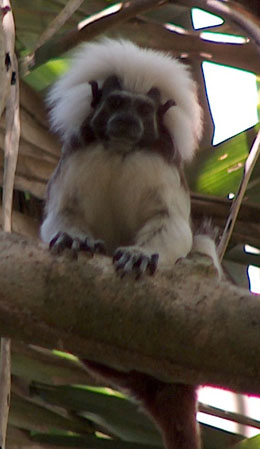Tiny primate ‘punk’ in danger of extinction
A tiny, charismatic Colombian primate known for its distinctive punk-rock hairstyle, is in imminent danger of extinction, according to new population figures.
New research has revealed that numbers of the critically endangered cotton-top tamarin have drastically decreased over the last forty years.
The latest study, carried out in Colombia with methods created by researchers at the University of St Andrews, estimates that there are just over seven thousand of the species left in the wild.

The research uses a new population sampling method developed by Dr Len Thomas at the Centre for Research into Ecological and Environmental Modelling at St Andrews, in collaboration with Dr Anne Savage at Disney’s Animal Kingdom and Colombian NGO Proyecto Tití.
Dr Thomas commented, “Before our study, there was no reliable estimate of the number of these animals left in the wild, and no feasible method of counting them. All we knew was that between twenty – thirty thousand had been exported to the USA in the 1960s and 1970s for use in medical laboratories, before international trade was stopped. It took a lot of thinking, and several failed attempts, before we came up with a survey method that worked. Our results are quite shocking, because they demonstrate that almost all of the forest where cotton-top tamarins used to live has been cut down. We have documented, at least in the areas we could safely survey, where the last remaining wild animals are living, so conservation organizations can focus their efforts on preserving and hopefully expanding these remnant populations. Because of our work, cotton-top tamarins are on the List of the World’s 25 Most Endangered Primates.”
Cotton-top tamarins are endemic to northwestern Colombia, where they are known locally as “Titís”. They are threatened by habitat destruction, where natural forest is converted to cattle pasture, and trees are used for housing and fuel. They are also captured as part of an illegal wildlife trade.
Dr Thomas collaborated with Dr Anne Savage of Disney’s Animal Kingdom in the study. Dr Savage has worked on cotton-top tamarins for many years, founding Projecto Tití, a multidisciplinary conservation program that works to conserve this species by developing effective education programs and sustainable alternatives for communities to reduce their dependence on extracting products from the forests that the tamarins need to survive.
The seeds of the collaboration were sown back in 2003, at a training workshop in St Andrews co-taught by Dr Thomas and attended by Dr Savage. Counting cotton-tops was clearly a difficult problem since the tiny animals – just 25cm long – live 20m up in the forest canopy and flee at the first sign of humans. However, Dr Savage knew that they were attracted to playback recordings of tamarin vocalizations and that proved to be the key to surveying this shy primate. The method they developed involves two teams walking along parallel transects, playing recordings of cotton-top tamarin long calls and counting all the animals that came from between the teams to find the source of the vocalization. Cotton-tops readily responded to hearing an “intruder” in their territory and displayed appropriate behaviour of investigating the source of the “unfamiliar cotton-top”
Dr Savage, who also works with Joanne Potts, a St Andrews PhD student in studies of endangered small mammals in Florida, commented, “Our partnership with the University of St Andrews has been instrumental in helping to establish accurate population estimates for Key Largo woodrats, an endangered rodent species found in Florida.”
The research is published in the journal Nature Communications.
Ends
Note to Editors
Dr Len Thomas is available for interview on 01334 461801 / 07872 419039 or email [email protected].
Anne Savage (Disney’s Animal Kingdom, Lake Buena vista, FL, USA) is also available via Disney media relations on tel: +1 407 828 3814 or email: [email protected].
The research article will be available online at the Nature Communications website from 4pm on Tuesday 28 June.
Images are available from the Press Office – contacts below.
Issued by the Press Office, University of St Andrews
Contact Emma Shea, Communications Manager on 01334 462 109 or email [email protected].
View the latest University press releases at www.st-andrews.ac.uk
Category Research